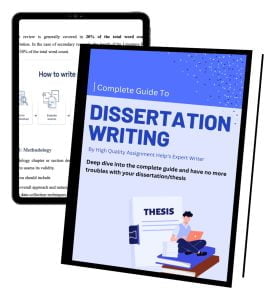The chapter arrangement is one of the most important considerations when writing a dissertation. A dissertation is a significant academic paper that needs to be ordered and detailed in order to successfully communicate the study findings. According to the study area and the kind of research done, the dissertation chapter arrangement differs.This article will explore the standard chapters in a dissertation, the number of chapters, and what each chapter entails with the help of writing service help.
Understanding the Purpose of a Dissertation
Before we discuss the chapters of a dissertation, it is essential to understand the purpose of a dissertation. A dissertation is an extended research that explores a particular topic in-depth. The primary goal of a dissertation is to contribute new knowledge to your field of study by conducting original research. A dissertation should demonstrate your ability to analyze and synthesize complex information and be written clearly and concisely.
The Chapters of a Dissertation
Several chapters are needed for a thorough and well-structured research report, and a dissertation contains these chapters. These chapters also serve as the overarching framework for the dissertation and contain the introduction, literature review, methods, results, discussion, and conclusion.
Overview of the Dissertation Chapter Structure
Depending on your topic of study, research question, and supervisor’s requirements, your dissertation’s structure may change. Yet, the majority of dissertations have a similar format, with multiple chapters presenting your research’s conclusions and justifications.
The most typical dissertation chapters include the following:
Chapter1-Introduction
A dissertation’s first chapter, the introduction, establishes the overall tone for the work. It should give a general description of the research topic, the goal of the investigation, and the range of the study. A justification for the study and an explanation of why the research is necessary should also be included in the introduction.
Chapter2-Literature Review
The literature review is a critical chapter that provides an overview of the existing research on the topic. The chapter should analyze the relevant literature and identify any gaps in the research. The literature review should also provide a framework for the study and justify the research questions.
Chapter3-Methodology
The methodology chapter describes the data collection and analysis methods utilised in research. This chapter should cover the research design, sample selection, data collection, and analysis processes. The technique should cover all moral concerns and constraints on the investigation.
Chapter4-Results
The research’s conclusions are presented in the results chapter. The acquired data should be thoroughly described in the chapter, along with any statistical analyses. Also, the findings must to address the research questions and hypotheses.
Chapter5-Discussion
The discussion chapter analyses and contrasts the research findings with the body of prior knowledge. The results’ relevance and how they advance the field of study should be discussed throughout the chapter. The debate should also point out any shortcomings in the study and offer potential directions for further investigation.
Together, these dissertation chapters form a comprehensive and cohesive document that contributes to the body of knowledge in a particular field.
Conclusion
The research’s main conclusions are outlined in the concluding chapter, which also restates the research’s aims and questions. The significance of the study and its contribution to the field of study should also be discussed in the conclusion.
Also Read:How to write a conclusion for a nursing assignment
How to Write a Dissertation
Writing a chapters in a dissertation can be challenging, but it can be a rewarding experience with the right approach. Here are the basic steps you can follow to write a dissertation:
1-Determine Your Research Question
Choosing your research question is the first stage in creating a dissertation. This should be a succinct and unambiguous summary of the issue or subject you wish to research. Your research question needs to be both particular and broad enough to allow for a thorough investigation.
2-Conduct a Literature Review
Once you have your research question, you must do a literature review to find all of the previous studies that have been done on the subject. This will give you a framework for your research and help you find research gaps.
3-Develop a Methodology
You can create a research methodology based on your research topic and literature review. This should concisely outline the methodologies used for data gathering and analysis as well as your study strategy.
4-Collect and Analyze Data
Once your process is established, you can gather and examine data. This might entail conducting tests, surveys, interviews, or data analysis on already existing data sets.
5-Write the Chapters of Your Dissertation
After collecting and analysing your data, you can begin writing the chapters of your dissertation. Included in this list should be the introduction, literature review, methods, results, discussion, conclusion, and any extra chapters required by your programme.
By following these steps and strategies, you can produce high-quality chapters in a dissertation that contributes to your field of study and demonstrates your research skills and expertise.
Conclusion
Dissertation writing can be challenging and time-consuming, but it is essential for most doctoral programs. By understanding the dissertation chapter structure and content of a dissertation and following a systematic approach to writing, you can complete your dissertation successfully. Remember to stay organized, stay focused on your research question, and seek guidance and support from your research advisor and dissertation writing help.
Seeking professional dissertation writing services can be a great way to ensure that your dissertation is well-written, well-researched, and meets all of the necessary requirements. If you’re struggling with your dissertation, consider Assignment Unlocked which aims to support students by providing them with educational resources, assistance, and guidance tailored to their specific needs, ultimately enhancing their learning outcomes and academic success for more information visit on the website now.






